ACCT6007 Financial Accounting Theory: Fair Value Analysis Report
VerifiedAdded on 2023/02/01
|7
|1772
|60
Report
AI Summary
This report critically analyzes fair value accounting, a key concept in financial reporting. The analysis examines the advantages and disadvantages of fair value accounting, including its straightforward nature and its potential for market price fluctuations. It explores the three-tier process used in fair value accounting, detailing Level 1, Level 2, and Level 3 inputs, and discusses the qualitative characteristics in financial reporting. The report references academic articles and accounting standards to support its arguments, providing a comprehensive overview of fair value accounting's role in assessing company performance and its implications for investors' decision-making. The report highlights the importance of fair value in presenting accurate asset and liability values, enabling informed investment decisions.
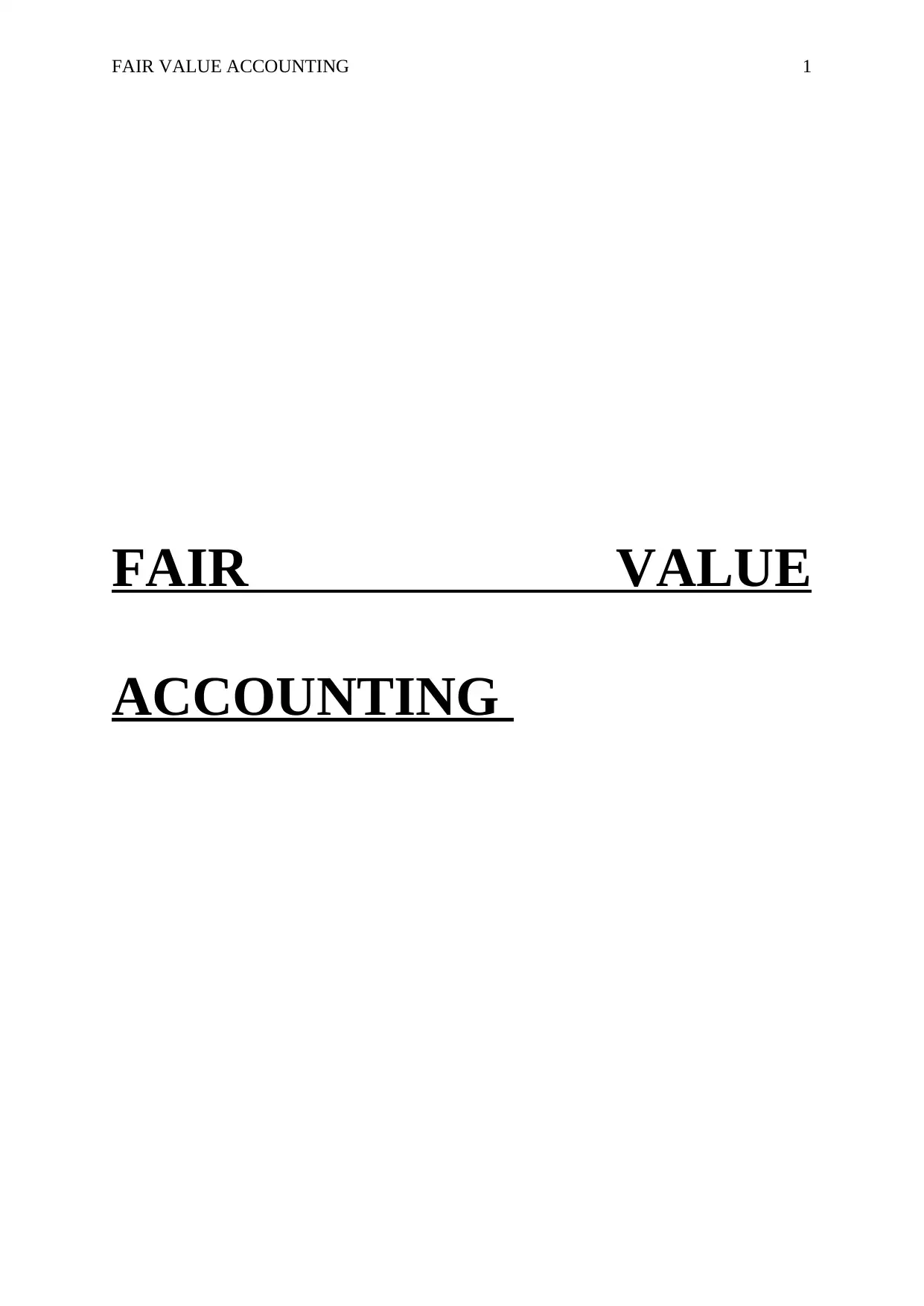
FAIR VALUE ACCOUNTING 1
FAIR VALUE
ACCOUNTING
FAIR VALUE
ACCOUNTING
Paraphrase This Document
Need a fresh take? Get an instant paraphrase of this document with our AI Paraphraser
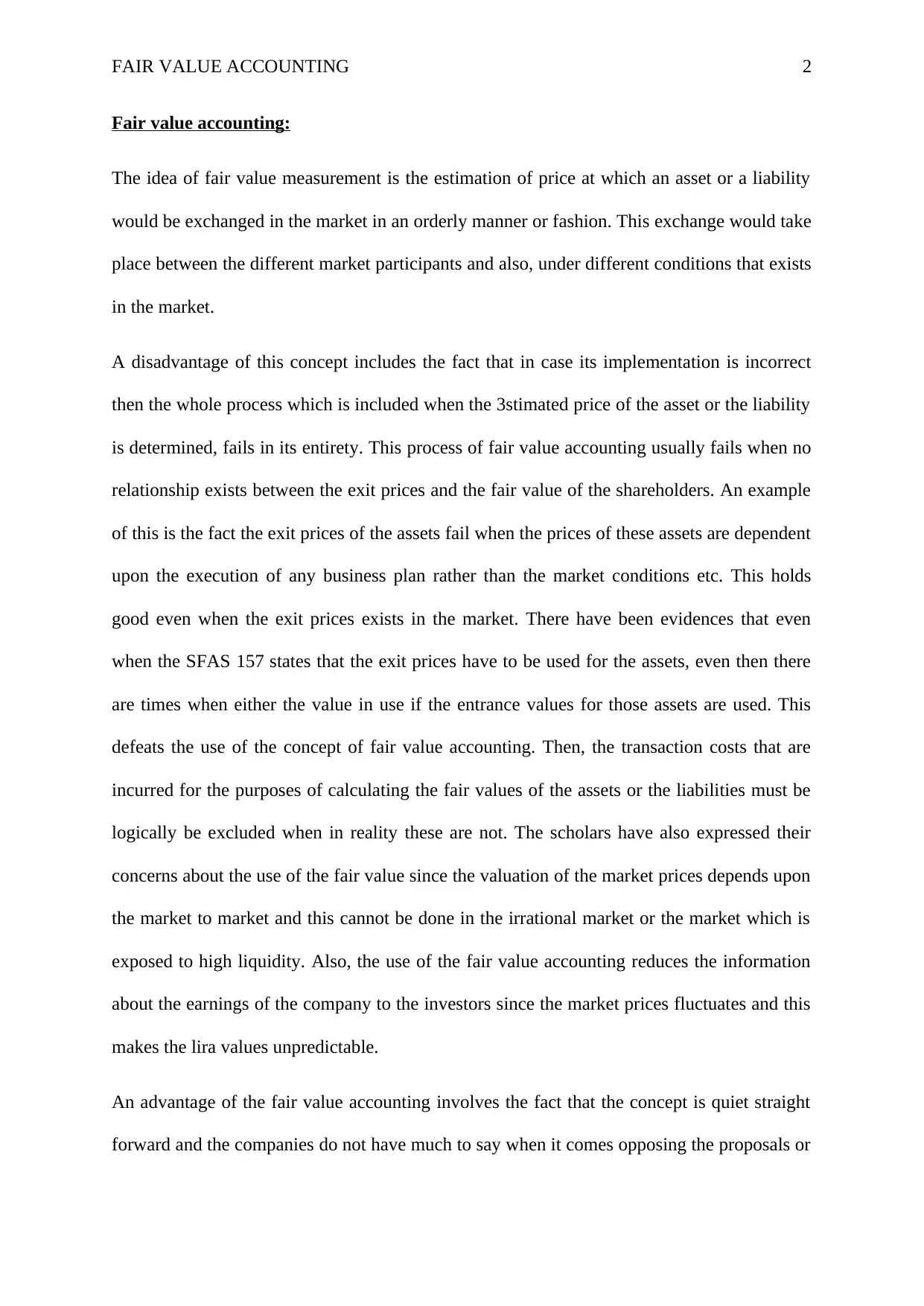
FAIR VALUE ACCOUNTING 2
Fair value accounting:
The idea of fair value measurement is the estimation of price at which an asset or a liability
would be exchanged in the market in an orderly manner or fashion. This exchange would take
place between the different market participants and also, under different conditions that exists
in the market.
A disadvantage of this concept includes the fact that in case its implementation is incorrect
then the whole process which is included when the 3stimated price of the asset or the liability
is determined, fails in its entirety. This process of fair value accounting usually fails when no
relationship exists between the exit prices and the fair value of the shareholders. An example
of this is the fact the exit prices of the assets fail when the prices of these assets are dependent
upon the execution of any business plan rather than the market conditions etc. This holds
good even when the exit prices exists in the market. There have been evidences that even
when the SFAS 157 states that the exit prices have to be used for the assets, even then there
are times when either the value in use if the entrance values for those assets are used. This
defeats the use of the concept of fair value accounting. Then, the transaction costs that are
incurred for the purposes of calculating the fair values of the assets or the liabilities must be
logically be excluded when in reality these are not. The scholars have also expressed their
concerns about the use of the fair value since the valuation of the market prices depends upon
the market to market and this cannot be done in the irrational market or the market which is
exposed to high liquidity. Also, the use of the fair value accounting reduces the information
about the earnings of the company to the investors since the market prices fluctuates and this
makes the lira values unpredictable.
An advantage of the fair value accounting involves the fact that the concept is quiet straight
forward and the companies do not have much to say when it comes opposing the proposals or
Fair value accounting:
The idea of fair value measurement is the estimation of price at which an asset or a liability
would be exchanged in the market in an orderly manner or fashion. This exchange would take
place between the different market participants and also, under different conditions that exists
in the market.
A disadvantage of this concept includes the fact that in case its implementation is incorrect
then the whole process which is included when the 3stimated price of the asset or the liability
is determined, fails in its entirety. This process of fair value accounting usually fails when no
relationship exists between the exit prices and the fair value of the shareholders. An example
of this is the fact the exit prices of the assets fail when the prices of these assets are dependent
upon the execution of any business plan rather than the market conditions etc. This holds
good even when the exit prices exists in the market. There have been evidences that even
when the SFAS 157 states that the exit prices have to be used for the assets, even then there
are times when either the value in use if the entrance values for those assets are used. This
defeats the use of the concept of fair value accounting. Then, the transaction costs that are
incurred for the purposes of calculating the fair values of the assets or the liabilities must be
logically be excluded when in reality these are not. The scholars have also expressed their
concerns about the use of the fair value since the valuation of the market prices depends upon
the market to market and this cannot be done in the irrational market or the market which is
exposed to high liquidity. Also, the use of the fair value accounting reduces the information
about the earnings of the company to the investors since the market prices fluctuates and this
makes the lira values unpredictable.
An advantage of the fair value accounting involves the fact that the concept is quiet straight
forward and the companies do not have much to say when it comes opposing the proposals or
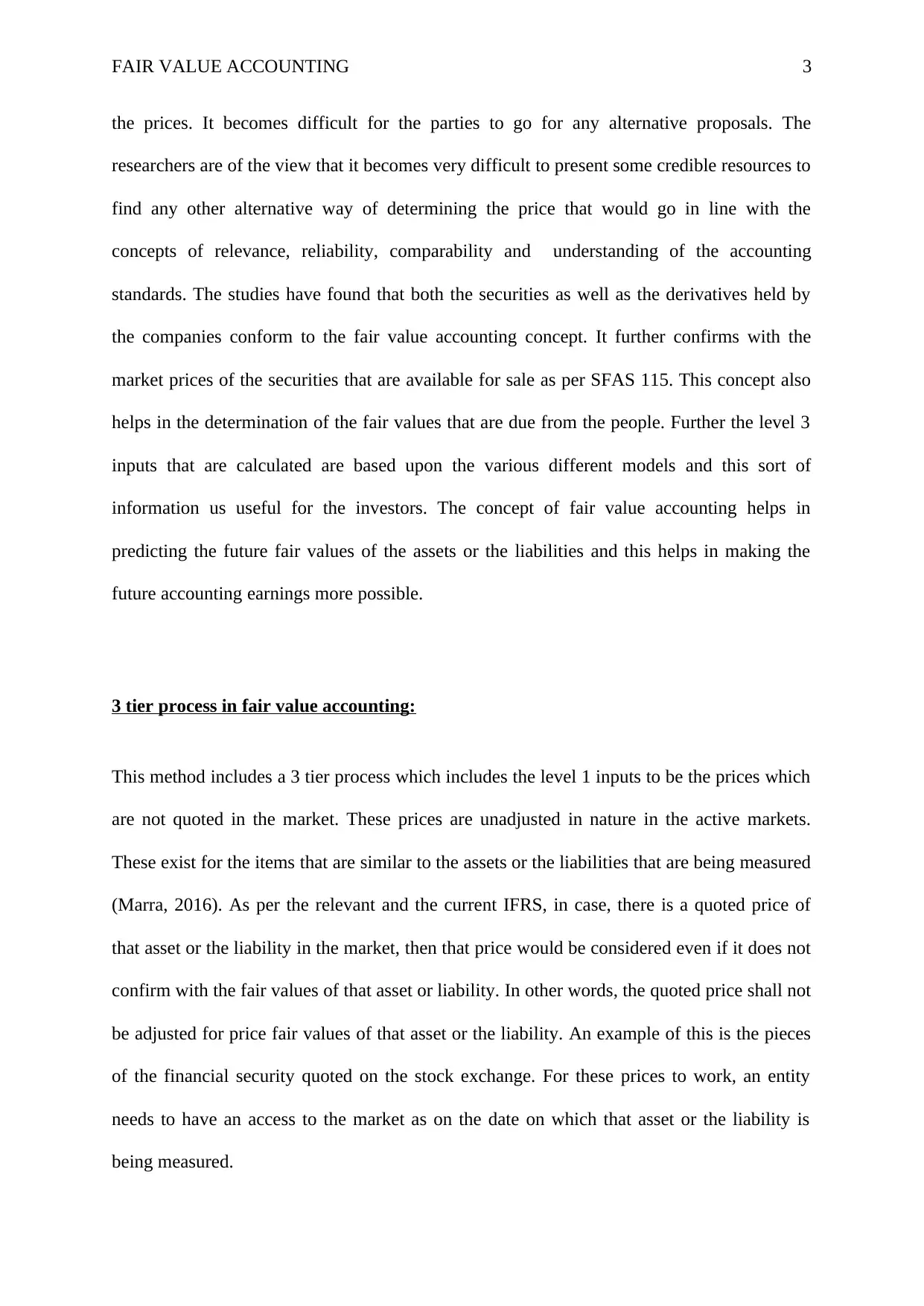
FAIR VALUE ACCOUNTING 3
the prices. It becomes difficult for the parties to go for any alternative proposals. The
researchers are of the view that it becomes very difficult to present some credible resources to
find any other alternative way of determining the price that would go in line with the
concepts of relevance, reliability, comparability and understanding of the accounting
standards. The studies have found that both the securities as well as the derivatives held by
the companies conform to the fair value accounting concept. It further confirms with the
market prices of the securities that are available for sale as per SFAS 115. This concept also
helps in the determination of the fair values that are due from the people. Further the level 3
inputs that are calculated are based upon the various different models and this sort of
information us useful for the investors. The concept of fair value accounting helps in
predicting the future fair values of the assets or the liabilities and this helps in making the
future accounting earnings more possible.
3 tier process in fair value accounting:
This method includes a 3 tier process which includes the level 1 inputs to be the prices which
are not quoted in the market. These prices are unadjusted in nature in the active markets.
These exist for the items that are similar to the assets or the liabilities that are being measured
(Marra, 2016). As per the relevant and the current IFRS, in case, there is a quoted price of
that asset or the liability in the market, then that price would be considered even if it does not
confirm with the fair values of that asset or liability. In other words, the quoted price shall not
be adjusted for price fair values of that asset or the liability. An example of this is the pieces
of the financial security quoted on the stock exchange. For these prices to work, an entity
needs to have an access to the market as on the date on which that asset or the liability is
being measured.
the prices. It becomes difficult for the parties to go for any alternative proposals. The
researchers are of the view that it becomes very difficult to present some credible resources to
find any other alternative way of determining the price that would go in line with the
concepts of relevance, reliability, comparability and understanding of the accounting
standards. The studies have found that both the securities as well as the derivatives held by
the companies conform to the fair value accounting concept. It further confirms with the
market prices of the securities that are available for sale as per SFAS 115. This concept also
helps in the determination of the fair values that are due from the people. Further the level 3
inputs that are calculated are based upon the various different models and this sort of
information us useful for the investors. The concept of fair value accounting helps in
predicting the future fair values of the assets or the liabilities and this helps in making the
future accounting earnings more possible.
3 tier process in fair value accounting:
This method includes a 3 tier process which includes the level 1 inputs to be the prices which
are not quoted in the market. These prices are unadjusted in nature in the active markets.
These exist for the items that are similar to the assets or the liabilities that are being measured
(Marra, 2016). As per the relevant and the current IFRS, in case, there is a quoted price of
that asset or the liability in the market, then that price would be considered even if it does not
confirm with the fair values of that asset or liability. In other words, the quoted price shall not
be adjusted for price fair values of that asset or the liability. An example of this is the pieces
of the financial security quoted on the stock exchange. For these prices to work, an entity
needs to have an access to the market as on the date on which that asset or the liability is
being measured.
⊘ This is a preview!⊘
Do you want full access?
Subscribe today to unlock all pages.

Trusted by 1+ million students worldwide
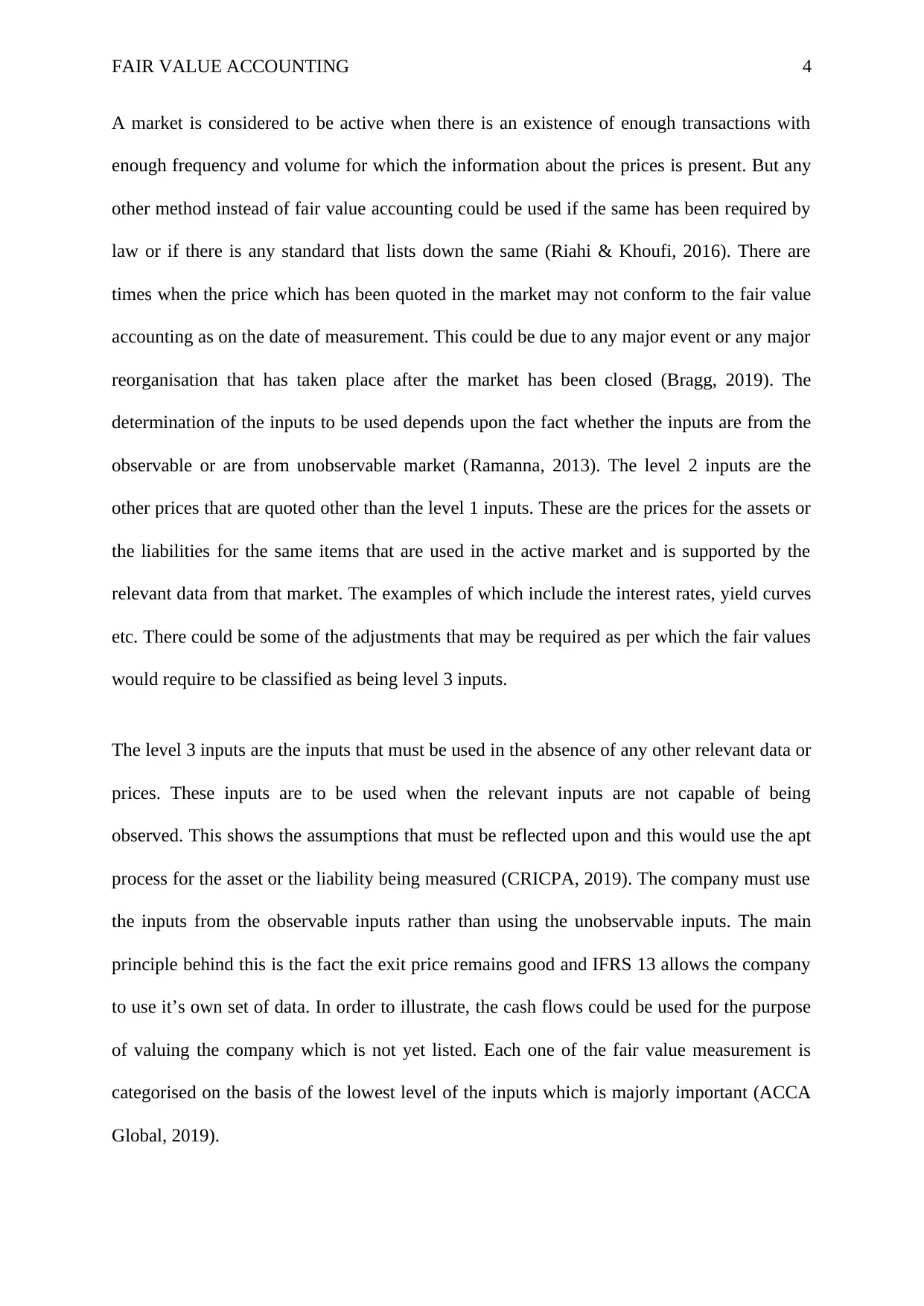
FAIR VALUE ACCOUNTING 4
A market is considered to be active when there is an existence of enough transactions with
enough frequency and volume for which the information about the prices is present. But any
other method instead of fair value accounting could be used if the same has been required by
law or if there is any standard that lists down the same (Riahi & Khoufi, 2016). There are
times when the price which has been quoted in the market may not conform to the fair value
accounting as on the date of measurement. This could be due to any major event or any major
reorganisation that has taken place after the market has been closed (Bragg, 2019). The
determination of the inputs to be used depends upon the fact whether the inputs are from the
observable or are from unobservable market (Ramanna, 2013). The level 2 inputs are the
other prices that are quoted other than the level 1 inputs. These are the prices for the assets or
the liabilities for the same items that are used in the active market and is supported by the
relevant data from that market. The examples of which include the interest rates, yield curves
etc. There could be some of the adjustments that may be required as per which the fair values
would require to be classified as being level 3 inputs.
The level 3 inputs are the inputs that must be used in the absence of any other relevant data or
prices. These inputs are to be used when the relevant inputs are not capable of being
observed. This shows the assumptions that must be reflected upon and this would use the apt
process for the asset or the liability being measured (CRICPA, 2019). The company must use
the inputs from the observable inputs rather than using the unobservable inputs. The main
principle behind this is the fact the exit price remains good and IFRS 13 allows the company
to use it’s own set of data. In order to illustrate, the cash flows could be used for the purpose
of valuing the company which is not yet listed. Each one of the fair value measurement is
categorised on the basis of the lowest level of the inputs which is majorly important (ACCA
Global, 2019).
A market is considered to be active when there is an existence of enough transactions with
enough frequency and volume for which the information about the prices is present. But any
other method instead of fair value accounting could be used if the same has been required by
law or if there is any standard that lists down the same (Riahi & Khoufi, 2016). There are
times when the price which has been quoted in the market may not conform to the fair value
accounting as on the date of measurement. This could be due to any major event or any major
reorganisation that has taken place after the market has been closed (Bragg, 2019). The
determination of the inputs to be used depends upon the fact whether the inputs are from the
observable or are from unobservable market (Ramanna, 2013). The level 2 inputs are the
other prices that are quoted other than the level 1 inputs. These are the prices for the assets or
the liabilities for the same items that are used in the active market and is supported by the
relevant data from that market. The examples of which include the interest rates, yield curves
etc. There could be some of the adjustments that may be required as per which the fair values
would require to be classified as being level 3 inputs.
The level 3 inputs are the inputs that must be used in the absence of any other relevant data or
prices. These inputs are to be used when the relevant inputs are not capable of being
observed. This shows the assumptions that must be reflected upon and this would use the apt
process for the asset or the liability being measured (CRICPA, 2019). The company must use
the inputs from the observable inputs rather than using the unobservable inputs. The main
principle behind this is the fact the exit price remains good and IFRS 13 allows the company
to use it’s own set of data. In order to illustrate, the cash flows could be used for the purpose
of valuing the company which is not yet listed. Each one of the fair value measurement is
categorised on the basis of the lowest level of the inputs which is majorly important (ACCA
Global, 2019).
Paraphrase This Document
Need a fresh take? Get an instant paraphrase of this document with our AI Paraphraser
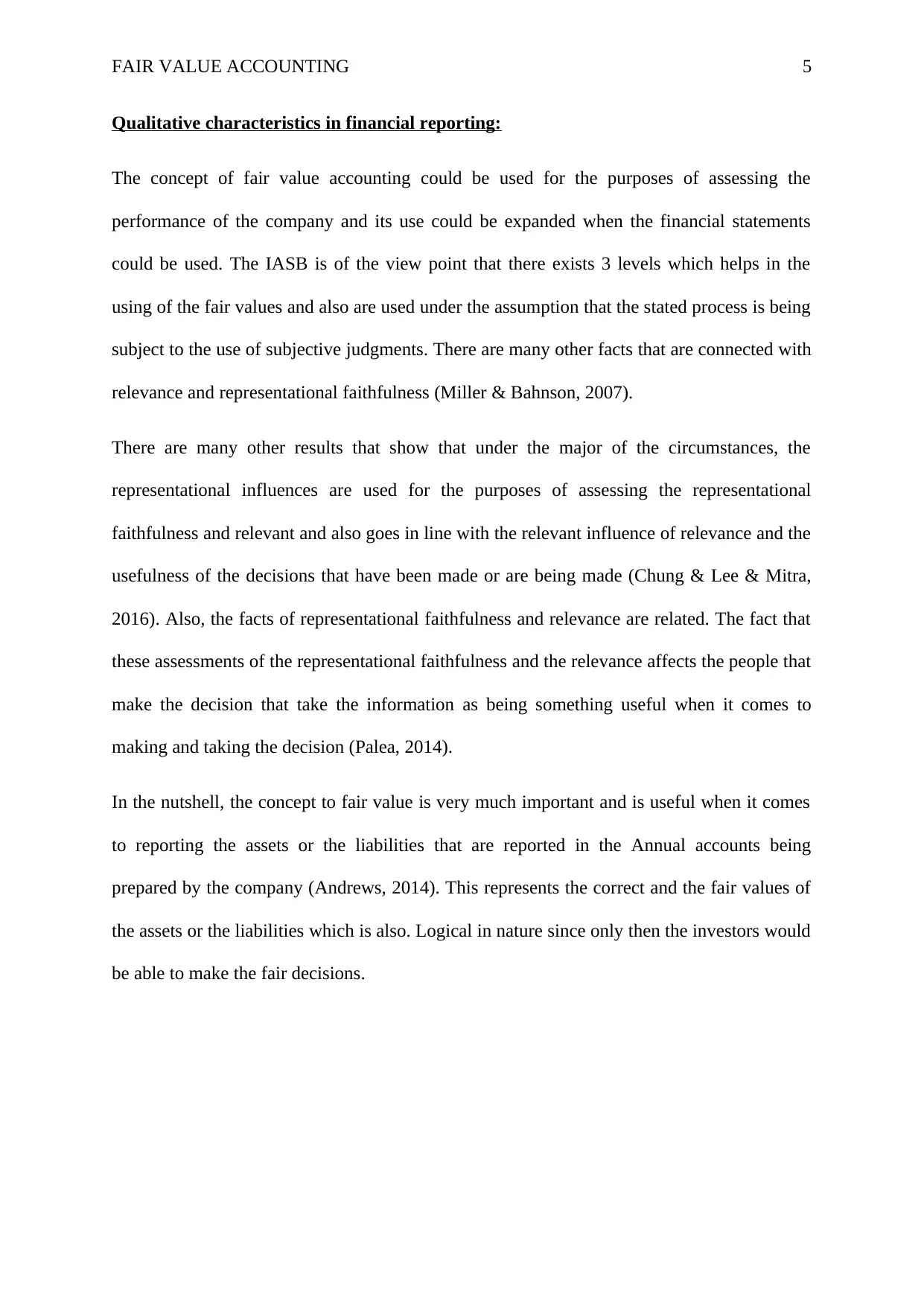
FAIR VALUE ACCOUNTING 5
Qualitative characteristics in financial reporting:
The concept of fair value accounting could be used for the purposes of assessing the
performance of the company and its use could be expanded when the financial statements
could be used. The IASB is of the view point that there exists 3 levels which helps in the
using of the fair values and also are used under the assumption that the stated process is being
subject to the use of subjective judgments. There are many other facts that are connected with
relevance and representational faithfulness (Miller & Bahnson, 2007).
There are many other results that show that under the major of the circumstances, the
representational influences are used for the purposes of assessing the representational
faithfulness and relevant and also goes in line with the relevant influence of relevance and the
usefulness of the decisions that have been made or are being made (Chung & Lee & Mitra,
2016). Also, the facts of representational faithfulness and relevance are related. The fact that
these assessments of the representational faithfulness and the relevance affects the people that
make the decision that take the information as being something useful when it comes to
making and taking the decision (Palea, 2014).
In the nutshell, the concept to fair value is very much important and is useful when it comes
to reporting the assets or the liabilities that are reported in the Annual accounts being
prepared by the company (Andrews, 2014). This represents the correct and the fair values of
the assets or the liabilities which is also. Logical in nature since only then the investors would
be able to make the fair decisions.
Qualitative characteristics in financial reporting:
The concept of fair value accounting could be used for the purposes of assessing the
performance of the company and its use could be expanded when the financial statements
could be used. The IASB is of the view point that there exists 3 levels which helps in the
using of the fair values and also are used under the assumption that the stated process is being
subject to the use of subjective judgments. There are many other facts that are connected with
relevance and representational faithfulness (Miller & Bahnson, 2007).
There are many other results that show that under the major of the circumstances, the
representational influences are used for the purposes of assessing the representational
faithfulness and relevant and also goes in line with the relevant influence of relevance and the
usefulness of the decisions that have been made or are being made (Chung & Lee & Mitra,
2016). Also, the facts of representational faithfulness and relevance are related. The fact that
these assessments of the representational faithfulness and the relevance affects the people that
make the decision that take the information as being something useful when it comes to
making and taking the decision (Palea, 2014).
In the nutshell, the concept to fair value is very much important and is useful when it comes
to reporting the assets or the liabilities that are reported in the Annual accounts being
prepared by the company (Andrews, 2014). This represents the correct and the fair values of
the assets or the liabilities which is also. Logical in nature since only then the investors would
be able to make the fair decisions.
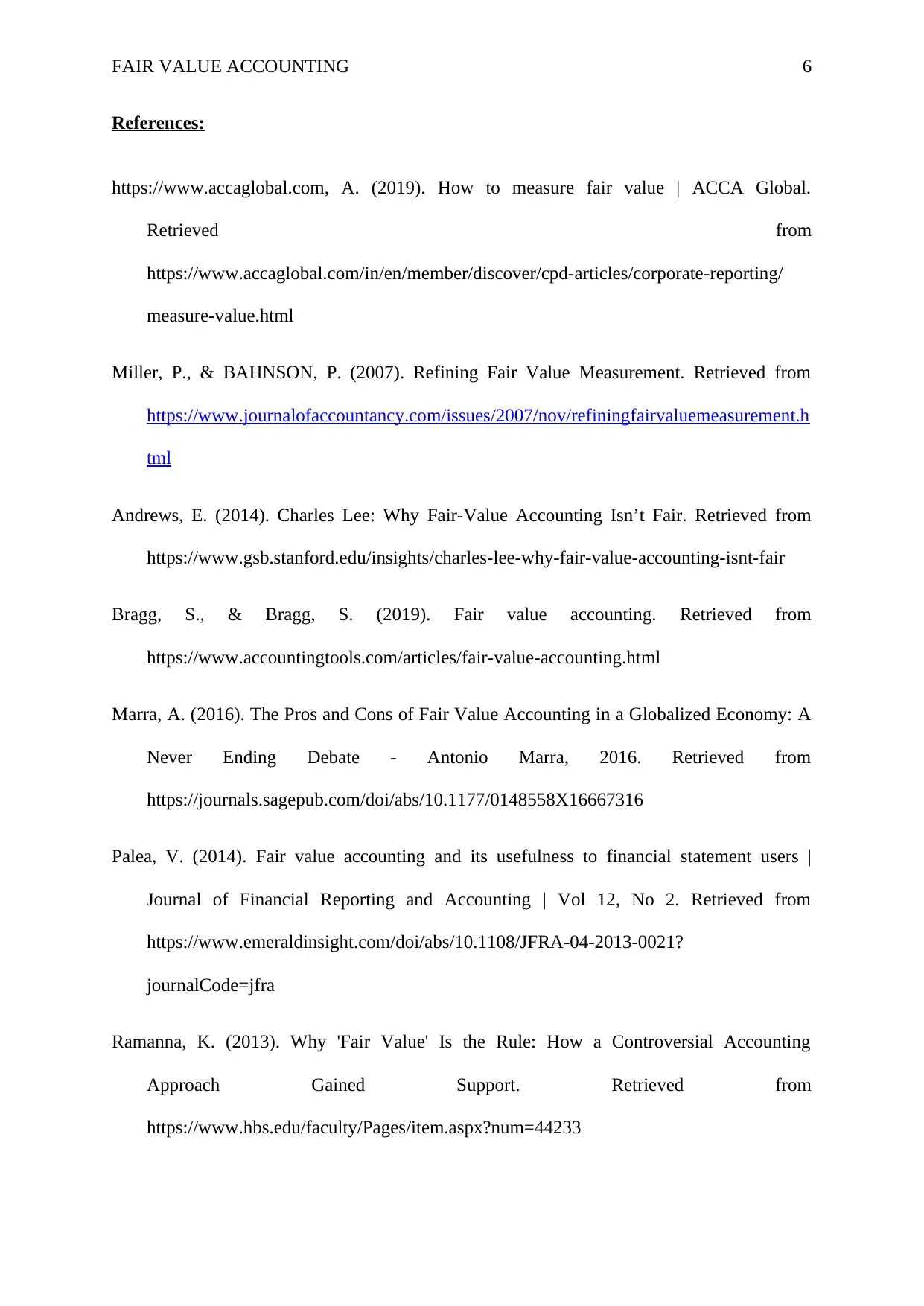
FAIR VALUE ACCOUNTING 6
References:
https://www.accaglobal.com, A. (2019). How to measure fair value | ACCA Global.
Retrieved from
https://www.accaglobal.com/in/en/member/discover/cpd-articles/corporate-reporting/
measure-value.html
Miller, P., & BAHNSON, P. (2007). Refining Fair Value Measurement. Retrieved from
https://www.journalofaccountancy.com/issues/2007/nov/refiningfairvaluemeasurement.h
tml
Andrews, E. (2014). Charles Lee: Why Fair-Value Accounting Isn’t Fair. Retrieved from
https://www.gsb.stanford.edu/insights/charles-lee-why-fair-value-accounting-isnt-fair
Bragg, S., & Bragg, S. (2019). Fair value accounting. Retrieved from
https://www.accountingtools.com/articles/fair-value-accounting.html
Marra, A. (2016). The Pros and Cons of Fair Value Accounting in a Globalized Economy: A
Never Ending Debate - Antonio Marra, 2016. Retrieved from
https://journals.sagepub.com/doi/abs/10.1177/0148558X16667316
Palea, V. (2014). Fair value accounting and its usefulness to financial statement users |
Journal of Financial Reporting and Accounting | Vol 12, No 2. Retrieved from
https://www.emeraldinsight.com/doi/abs/10.1108/JFRA-04-2013-0021?
journalCode=jfra
Ramanna, K. (2013). Why 'Fair Value' Is the Rule: How a Controversial Accounting
Approach Gained Support. Retrieved from
https://www.hbs.edu/faculty/Pages/item.aspx?num=44233
References:
https://www.accaglobal.com, A. (2019). How to measure fair value | ACCA Global.
Retrieved from
https://www.accaglobal.com/in/en/member/discover/cpd-articles/corporate-reporting/
measure-value.html
Miller, P., & BAHNSON, P. (2007). Refining Fair Value Measurement. Retrieved from
https://www.journalofaccountancy.com/issues/2007/nov/refiningfairvaluemeasurement.h
tml
Andrews, E. (2014). Charles Lee: Why Fair-Value Accounting Isn’t Fair. Retrieved from
https://www.gsb.stanford.edu/insights/charles-lee-why-fair-value-accounting-isnt-fair
Bragg, S., & Bragg, S. (2019). Fair value accounting. Retrieved from
https://www.accountingtools.com/articles/fair-value-accounting.html
Marra, A. (2016). The Pros and Cons of Fair Value Accounting in a Globalized Economy: A
Never Ending Debate - Antonio Marra, 2016. Retrieved from
https://journals.sagepub.com/doi/abs/10.1177/0148558X16667316
Palea, V. (2014). Fair value accounting and its usefulness to financial statement users |
Journal of Financial Reporting and Accounting | Vol 12, No 2. Retrieved from
https://www.emeraldinsight.com/doi/abs/10.1108/JFRA-04-2013-0021?
journalCode=jfra
Ramanna, K. (2013). Why 'Fair Value' Is the Rule: How a Controversial Accounting
Approach Gained Support. Retrieved from
https://www.hbs.edu/faculty/Pages/item.aspx?num=44233
⊘ This is a preview!⊘
Do you want full access?
Subscribe today to unlock all pages.

Trusted by 1+ million students worldwide
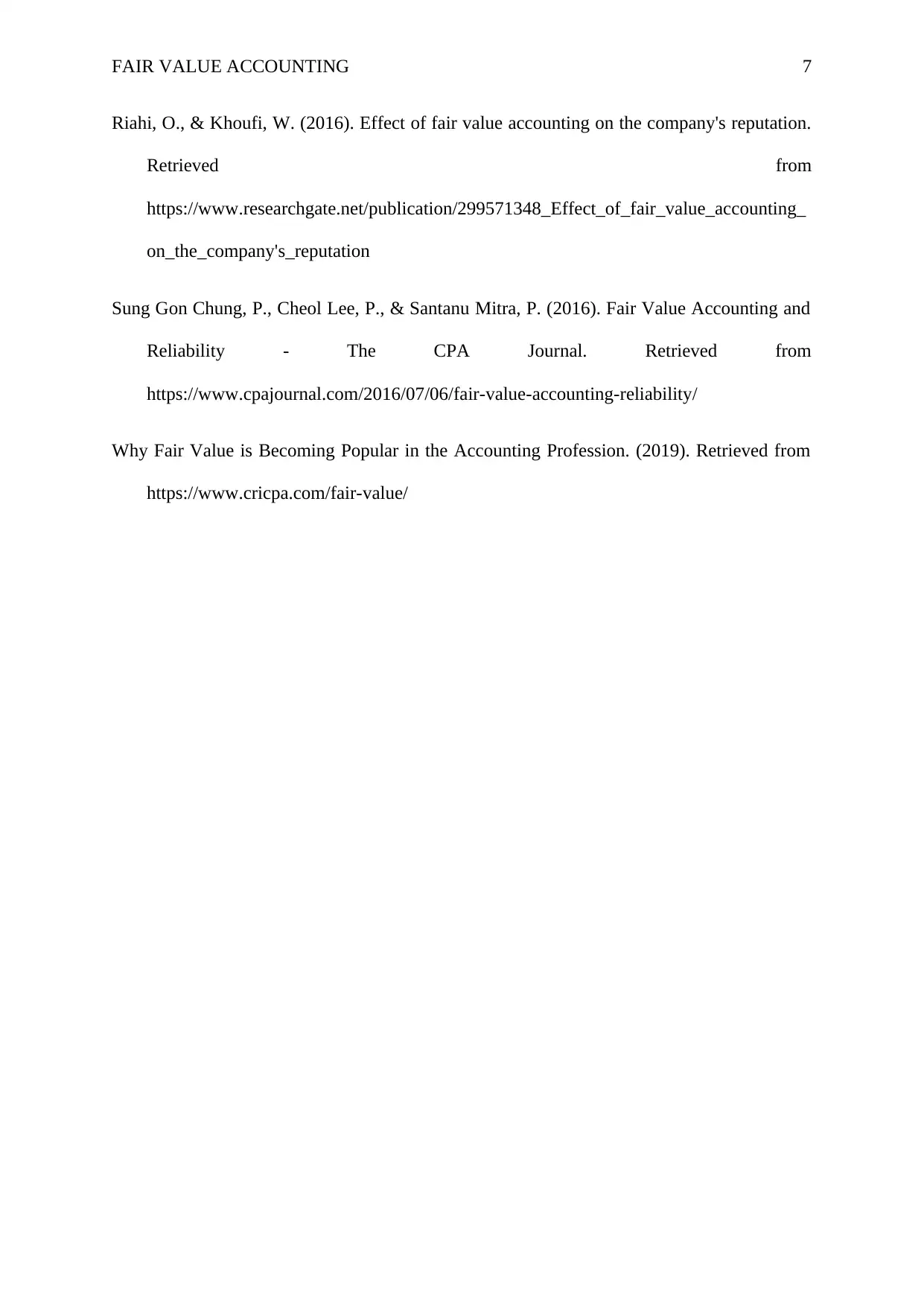
FAIR VALUE ACCOUNTING 7
Riahi, O., & Khoufi, W. (2016). Effect of fair value accounting on the company's reputation.
Retrieved from
https://www.researchgate.net/publication/299571348_Effect_of_fair_value_accounting_
on_the_company's_reputation
Sung Gon Chung, P., Cheol Lee, P., & Santanu Mitra, P. (2016). Fair Value Accounting and
Reliability - The CPA Journal. Retrieved from
https://www.cpajournal.com/2016/07/06/fair-value-accounting-reliability/
Why Fair Value is Becoming Popular in the Accounting Profession. (2019). Retrieved from
https://www.cricpa.com/fair-value/
Riahi, O., & Khoufi, W. (2016). Effect of fair value accounting on the company's reputation.
Retrieved from
https://www.researchgate.net/publication/299571348_Effect_of_fair_value_accounting_
on_the_company's_reputation
Sung Gon Chung, P., Cheol Lee, P., & Santanu Mitra, P. (2016). Fair Value Accounting and
Reliability - The CPA Journal. Retrieved from
https://www.cpajournal.com/2016/07/06/fair-value-accounting-reliability/
Why Fair Value is Becoming Popular in the Accounting Profession. (2019). Retrieved from
https://www.cricpa.com/fair-value/
1 out of 7
Related Documents
Your All-in-One AI-Powered Toolkit for Academic Success.
+13062052269
info@desklib.com
Available 24*7 on WhatsApp / Email
![[object Object]](/_next/static/media/star-bottom.7253800d.svg)
Unlock your academic potential
Copyright © 2020–2025 A2Z Services. All Rights Reserved. Developed and managed by ZUCOL.



